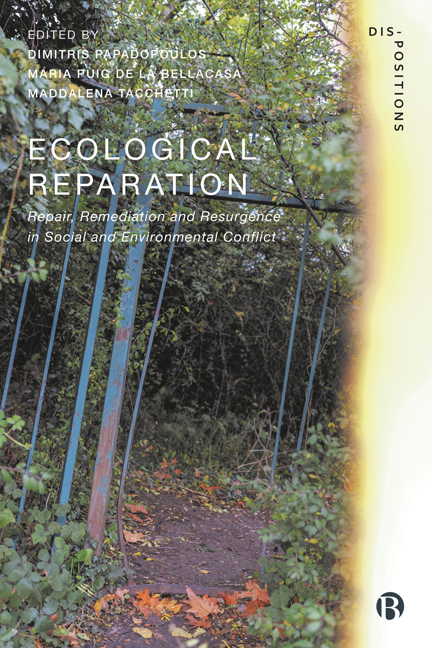Book contents
- Frontmatter
- Contents
- List of Figures
- Notes on Contributors
- Acknowledgements
- Note on the Figures
- Dis-Positions Series Preface
- Introduction: No Justice, No Ecological Peace: The Groundings of Ecological Reparation
- PART I Depletion<>Resurgence
- PART II Deskilling<>Experimenting
- PART III Contaminating<>Cohabiting
- PART IV Enclosing<>Reclaiming Land
- PART V Loss<>Recollecting
- PART VI Representing<>Self-governing
- PART VII Isolating<>Embodying
- PART VIII Growth<>Flourishing
- Index
26 - Ordinary Hope
Published online by Cambridge University Press: 28 March 2024
- Frontmatter
- Contents
- List of Figures
- Notes on Contributors
- Acknowledgements
- Note on the Figures
- Dis-Positions Series Preface
- Introduction: No Justice, No Ecological Peace: The Groundings of Ecological Reparation
- PART I Depletion<>Resurgence
- PART II Deskilling<>Experimenting
- PART III Contaminating<>Cohabiting
- PART IV Enclosing<>Reclaiming Land
- PART V Loss<>Recollecting
- PART VI Representing<>Self-governing
- PART VII Isolating<>Embodying
- PART VIII Growth<>Flourishing
- Index
Summary
The opening lines of The Human Condition, Hannah Arendt’s (1958) sweeping ‘reconsideration of the human condition from the vantage point of our newest experiences and our most recent fears’ (5) describe the Sputnik launch in 1957.
In 1957, an earth-born object made by man was launched into the universe, where for some weeks it circled the earth according to the same laws of gravitation that swing and keep in motion the celestial bodies – the sun, the moon, and the stars. To be sure, the man-made satellite was no moon or star, no heavenly body which could follow its circling path for a time span that to us mortals, bound by earthly time, lasts from eternity to eternity. Yet, for a time it managed to stay in the skies; it dwelt and moved in the proximity of the heavenly bodies as thought it had been admitted tentatively to their sublime company.
This event, second in importance to no other, not even the splitting of the atom, would have been greeted with unmitigated joy if it had not been for the uncomfortable military and political circumstances attending it. But, curiously enough, this joy was not triumphal; it was not pride or awe at the tremendousness of human power and mastery which filled the hearts of men, who now, when they looked up from the earth toward the skies, could behold there a thing of their own making. The immediate reaction, expressed on the spur of the moment, was relief about the first ‘step toward escape from men’s imprisonment to the earth’. And this strange statement, far from being the accidental slip of some American reporter, unwittingly echoed the extraordinary line which, more than twenty years ago, had been carved on the funeral obelisk for one of Russia’s great scientists: ‘Mankind will not remain bound to the earth forever.’
These lines also name the principal sentiment against which the alternative viewpoint that follows is offered. Like Arendt, I am unsettled by the dream of escape captured in this scene and countless others played out in the subsequent enthusiasms of sci fi writers, space aficionados, and billionaires – a dream that seems only to have grown as our sense of planetary fragility has intensified.
- Type
- Chapter
- Information
- Ecological ReparationRepair, Remediation and Resurgence in Social and Environmental Conflict, pp. 417 - 433Publisher: Bristol University PressPrint publication year: 2023

